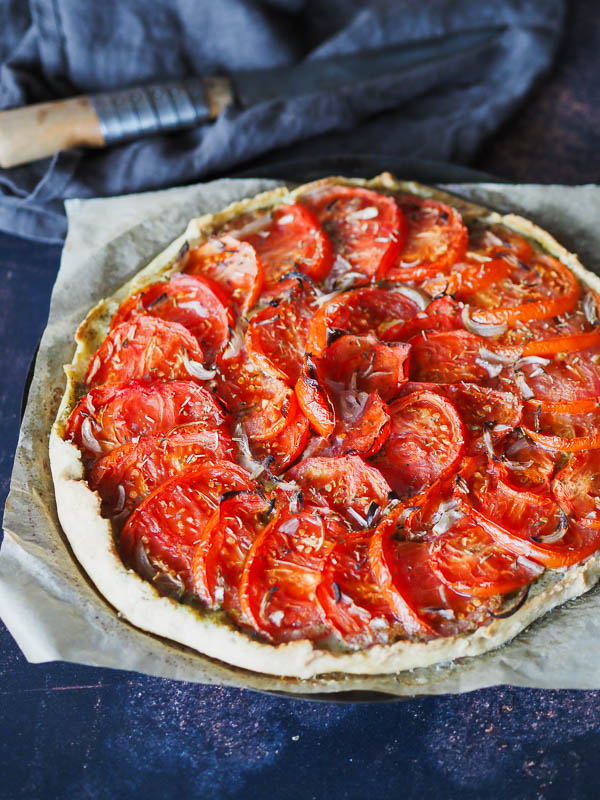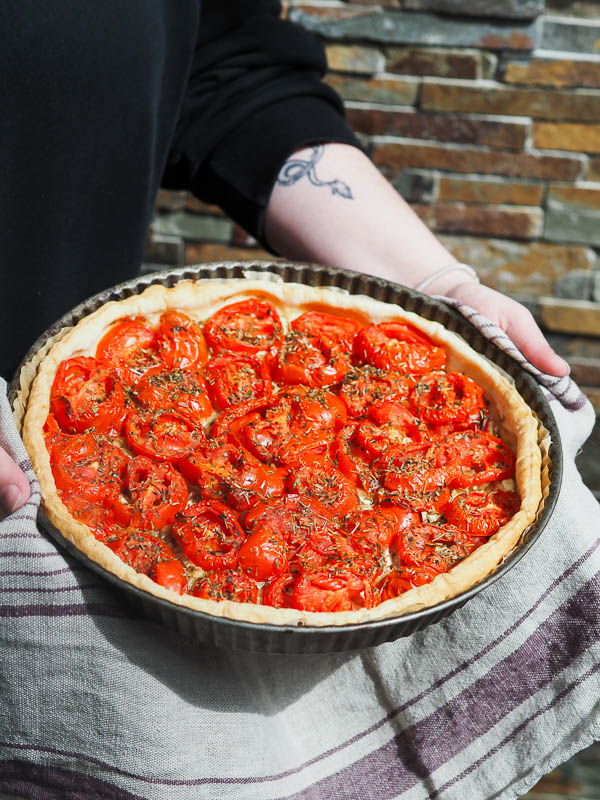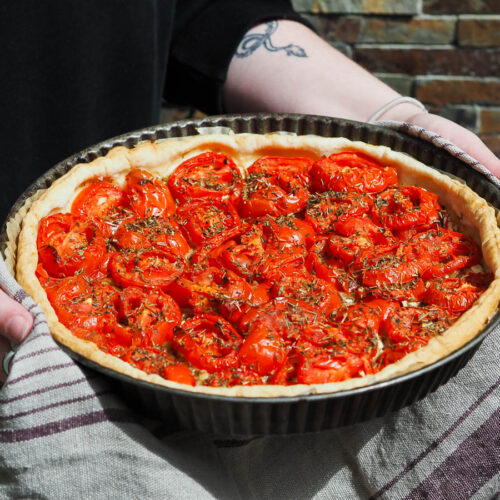Tomatoes on a bed of French Dijon mustard is a great classic savory tart in France. Don’t worry; mustard’s strength lowers when cooked. Here are my best tips and variations to make it easy and delightful. Gourmet option with feta or mozzarella cheese.

For me, the difference between a quiche and a savory tart is that quiche is a variety that always has an egg-and-cream custard with various fillings, from the classic quiche Lorraine with bacon to all the possible variations with salmon, spring vegetables, caramelized onion…
As for savory tart, tarte à la tomate, as we say in French (we don’t mention with Dijon mustard as when referring to tomato tart, it’s obvious we add mustard!!!) might be the best recipe, don’t you think?
For me it actually competes with my mom’s roasted bell pepper tart, a variation on the quiche with peppers on a bed of tomato coulis.
The tart pastry
You can use homemade or store-bought shortcrust or puff pastry. Here, I suggest a puff pastry.
Roll out the pastry in a pie dish. I recommend a metal dish that conducts the heat better and gives you better-cooked dough than a porcelain or glass dish.
Or, folding over the edges, you can make your tomato tart in a galette shape (we call it tarte rustique / rustic tart). This is also a good idea and often makes a very pretty presentation.
Which mustard to choose
The famous tomato tart is most often made simply with the classic Dijon mustard. Don’t worry; the strength of the mustard diminishes with baking, as it does in an other recipe I cook very often, pork meat coated in mustard. Mustard’s strength lowers but taste remains.
So choose Dijon mustard or replace it with old-fashioned grainy mustard. I once tried it with tarragon mustard, which was also nice. So have fun with flavored mustards…
The classic recipe for this tomato tart often uses mustard only. I like to mix mustard with cream cheese or crème fraîche, which I spread on my pie pastry. I’ve suggested this in the below recipe.
The proportion is half and half for a spicy taste; otherwise, one-third mustard – and two-thirds cream cheese.

Tomatoes
Choose plump tomatoes with a little juice. Here, I had oval-shaped tomatoes that were curiously seedless and dense.
To ensure that the tomatoes don’t give off too much water during baking, we cut them into slices, remove the seeds, and place them in a dish lined with kitchen paper to release as much juice as possible.
I start with this step and leave them like that for about fifteen minutes, which is the time it takes me to prepare the sautéed onion and the tart base (rolled-out pastry covered with the mustard mixture).
Play with tomato varieties and colors: the black Crimean tomato, the red, orange/yellow pineapple tomato and the green zebra tomato, and have fun making a rainbow.
But whatever you do, be generous with tomatoes and don’t hesitate to either overlap the tomato slices or make several layers (your tart will be more balanced than if you only have one layer of tomatoes) or arrange them nicely, as we do for Tian.
Cutting cherry tomatoes in half and scooping out their juice is also fun, but it’s a lot of work! This is a quick, no-fuss recipe.
Optional: sautéed onions
Adding sautéed onions is completely optional, it is my personal touch for a variation on the traditional recipe.
Just sauté minced onion and coarsely chopped garlic in olive oil with herbes de Provence or fresh thyme. I just sear them or cook them almost candied, and arrange the onions on the mustard before adding the tomatoes. You may also add them on top of tomatoes, as you wish.
Optional, add cheese
This tart is perfect eaten warm out of the oven or cold for a picnic or a simple lunch on the go.
You can opt for a variation with cheese, which takes gourmet pleasure to the next level! So, grated cheese (Gruyère or, better still, Comté or Parmesan)? Not for me. Or mozzarella or feta? Why not…
Option 1 = feta Choose a Greek PDO feta cheese made mainly from sheep’s milk. 5 to 10 minutes before the end of baking time, or when reheating the tart, crumble the feta here and there over the tart and place back in the oven to warm up and melt a little the cheese.
Option 2 = mozzarella Use mozzarella or, better still, burrata with a runny center. For mozzarella, proceed as for feta but if you choose burrata, I recommend placing it in the center of your tomato tart, just out of the oven when you come to the table. Open it when you cut your tart, and make sure to put a piece on each slice when you serve it.
You sometimes see photos of tomato tarts with slices of mozzarella sandwiched between the tomato slices, but I wouldn’t recommend it as the mozzarella doesn’t need to spend as much time in the oven.
Option 3 = fresh goat cheese, not bad either. Proceed as for the feta.
And coming soon, a variation of this tomato tart with tuna.



Tomato Tart with Dijon Mustard
Ingredients
- 1 puff pastry
- 1 tablespoon Dijon mustard
- 2 tablespoons cream cheese optional but recommended
- 1 kilo tomatoes
- salt
- pepper
- 1 tablespoon herbes de Provence
Optional
- 2 onions
- 2 cloves garlic
- 1 tablespoon olive oil
- 75 gr cheese feta or 1 mozzarella or burrata cheese
Instructions
- Preheat oven to 180°C / 350°F.
Prepare the tomatoes
- Rinse and dry the tomatoes. Lay out paper towels on a large plate.
- Cut the tomatoes into slices. Remove the seeds and juice. Place them on the paper towel to drain well.
Sauté the onions
- Heat a tablespoon of olive oil in a frying pan. Peel and chop the onion and garlic. Add them to the pan, season with salt and a little herbes de Provence, and fry for ten minutes over medium-high heat.
Prepare the tart
- Roll out the pie pastry in a tart pan. Place a large tablespoon of Dijon mustard and 2 tablespoons of cream cheese in the center. Mix together and spread over the whole tart base.
- Cover with the sautéed onions.
- Arrange the tomato slices, season with salt and pepper and sprinkle with herbes de Provence.
Bake
- Bake the tart for 30 to 40 minutes at 180°C / 350°F.
- If you choose feta or mozzarella cheese, add the crumbled cheese 5 to 10 minutes before the end of the baking time. If you choose burrata, place it in the center of the tart as soon as it comes out of the oven.
